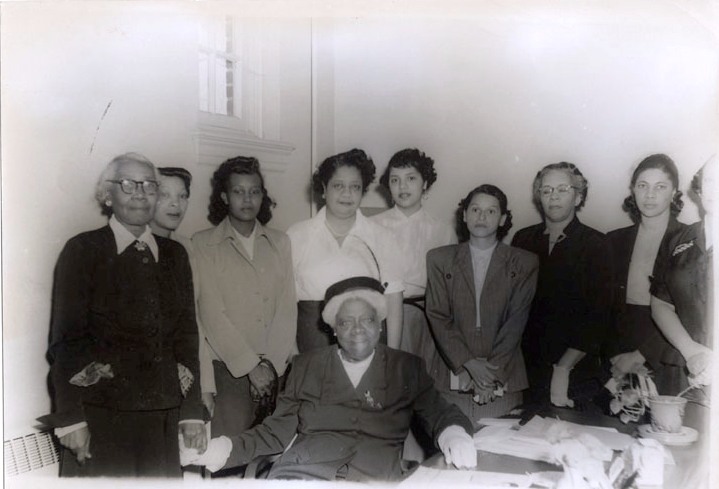Standing: (left to right):
Fannie C. Williams, Vera Savwoir, Mrs. Lefroy, Isabel E. Carter, Eloise Dunn Merrick, Mrs. Desvigne, Mrs. Hardin, Olga J. Spears
Seated: Mary McLeod Bethune
It was an honor in March of 1954 when Dr. Mary McLeod Bethune arrived at Valena C. Jones Elementary School in New Orleans as a special guest on their campus. Seen in the above photo with Dr. Bethune is Miss Fannie C. Williams, principal of the school, and seven members of her staff.
Dr. Bethune was en route to Daytona Beach, Florida after returning from Southern University where she delivered the Founders’ Day address. Dr. Felton Clark made possible this great privilege which the Jones’ family truly enjoyed and one that many of its students would remember in future years and mention as an important highlight of their days at the school.
It was a thrilling sight to see all the students who passed before Mrs. Bethune and listened to her speech given before the student body. She spoke of the great advantage each child had as he/she developed thinking skills, followed the golden rules, and grew into becoming a productive American citizen.
Before her arrival, many of Jones’ students (I’m sure) had learned of the vast accomplishments of this twentieth century American icon who, as an educator and fighter for social justice, accomplished so much for people of color in the United States, especially women.
Having been born in South Carolina in 1875 as the fifteenth of seventeen children to parents who were both slaves, Mary was determined to learn to read and write. This determination led her to attend a one-room schoolhouse that was run by the Presbyterian Board of Missions of Freedmen where she became the only child in her family to get an education. She walked eight miles each day to get there, but always returned home to teach her family what she had learned every day at school.
From this humble beginning, she would go on to become a teacher, founder of a school for Negro Girls in Florida whose benches and desks were made of discarded crates, ink for pens made from elderberry juice and pencils carved from burned wood. With financial assistance from local black churches and donations from wealthy benefactors, Mary’s school (Daytona Normal & Industrial Institute for Training Negro Girls) would eventually merge with Cookman Institute in 1929 to become Bethune-Cookman College. She became and would remain president from 1923 to 1942 and 1946 to 1947, one of the few women in the world to serve as a college president at that time.
In addition, Bethune (from 1920- 1950) would help establish and/ or govern some of the most significant black organizations in the country. She served under the administrations of both Presidents Coolidge and Hoover, but is best known for her association with President Franklin D. Roosevelt as the director of Negro Affairs in the New Deal National Youth Administration. In this capacity, she would become the first African American woman ever to occupy such a high position in the federal government.
Her awards were numerous and her accomplishments far outnumbered those few listed above; but the example she set as a role model for the young girls and boys at Jones Elementary, had to be very impressive.
Dr. Bethune passed away on May 18, 1955, just 14 months after her appearance at Valena C. Jones School. Fannie C. Williams retired as principal of Jones in 1954, after more than three decades in that capacity (1921-1954).
Sources: Amistad Research Center, Tulane University (photo); Louisiana Weekly, 27 March 1954 p.3; Wikipedia.org– Mary McLeod Bethune p. 1-9; www.amistadresearchcenter.org
Lolita V. Cherrie



